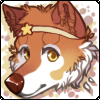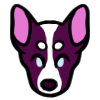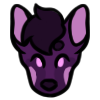Forum rules
Reminder: Copying another person's art without permission to reproduce their work is a form of art-theft!Click here to see the full Art Rules!
| Artist |
foreign-potato [gallery] |
| Time spent |
16 hours, 22 minutes |
| Drawing sessions |
40 |
| 68 people like this |
Log in to vote for this drawing
|
 by foreign-potato » Thu Jun 21, 2018 10:32 am
by foreign-potato » Thu Jun 21, 2018 10:32 am
★WHAT ARE HALINHI? QUICK BLURB- In short, Halinhi are an omnivorous, hermaphroditic species that live on another planet called Qaern in desert-like regions. On Qaern, they can interact with other species and novel humans alike to the ones found on Earth. They are primarily known for the mutations that affect their tails, causing them to always have more than one tail, and for their star-shaped pupils. Their ears and tails are often similar in form, and many mutations are possible. Because of this, Halinhi social structure tends to be dependent on their tails. Halinhi with more tails, or sometimes more complex tails, are often regarded as more prestigious or worthy. Also, Halinhi often are a part of one of three lifestyles: primitive, reformed, and domesticated. There is a lot to know about these creatures and I suggest you visit their information posts below!
Also to note: Halinhi have three main rarity categories (common, uncommon, & rare). Legendary traits are reserved for special occasions. Look below for the list of traits and rarities!
_______________________________________________________________________________________
★STAFF- Owner:
Ghost Artists:
Guest Artists:
★RULES- - Please don't copy anything! I worked really hard to create their look and backstory.
- You can not make your own unless you have specific permission from me or a real myo slot.
- Please don't edit your adopted Hali's design unless you ask me beforehand (and I may reject).
- Items are allowed, but read info under "lifestyles" to make sure your items fit your Halinhi's story.
- You can gift, readopt, or trade your Hali for ocs/site currency/art/etc. You can resell if the Hali was previously bought real currency or has bought art. Must be sold for equal price or less than the original price + extra bought art. You must let me know - for approval and to update the archives. Remember, deals with real currency must be done off CS.
- You can not transfer them off-species. Adopt them knowing they are to stay a part of the species!
- Do not breed them on your own! You must have an official artist do it or special permission from me.
- I don't mind them being your fursona, just give credit to the species!
- Please read their information before adopting!! Their world is a very important aspect of the species!
- I reserve the right to edit this in the future and to add more later :)
_______________________________________________________________________________________
★BULLETIN-
hello! . . .
hi!! long time no see, CS! I have been missing the adoptable atmosphere
that this site so wonderfully fosters, so I thought I would bring my little
species here for fun. I am in college and pretty busy so this is really
just a hobby for me, but I hope some people are interested in what
I will occasionally create. :'3c
to artists . . .
I edited the Hali's trait guide, so now it is more customizable on what you draw!
I have some pre-made tails, but feel free to draw your own or redraw
existing ones.
_______________________________________________________________________________________
Last edited by
foreign-potato on Wed Mar 06, 2019 4:45 pm, edited 43 times in total.
-

foreign-potato
-
- Posts: 8679
- Joined: Sun Feb 22, 2009 12:23 pm
- My pets
- My items
- My wishlist
- My gallery
- My scenes
- My dressups
- Trade with me
 by foreign-potato » Thu Jun 21, 2018 10:35 am
by foreign-potato » Thu Jun 21, 2018 10:35 am
_______________________________________________________________________________________
BASICS
★HABITATION Halinhi originate from an area that is very arid and dry on Qaern. It's comparable to Earth's savannas or desert shrublands, biomes where it's very hot and dry - but some water sources and plant life exist. Because of this, Hali tend to not like cold or wet environments.
★DIETHalinhi are opportunistic when it comes to food. They are omnivorous, though they tend to like being carnivores if given the chance. Fish, little mammals, fruits, plants, bugs, you name it. They will eat it, or at least try to! Because of their ancestry in the harsh desert with little food, they evolved to be able to eat a wide variety of things to maximize survival. Domesticated Hali have picked up a taste for human food, too.
★COMMUNICATIONHalinhi's own language is a series of chirps, purrs, and the occasional bleat. They can coexist with other species and learn their respective languages. More open-minded Hali are very warm to other species, while others, not so much. Hali are able to have pets themselves as they are conscious beings. It depends on their mentality and life style.
★REPRODUCTIONHalinhi can physically breed with any other Hali because they are hermaphroditic, but there are social boundaries to be crossed before breeding occurs. Social status often dictates who will breed. For instance, same tail number/type will interbreed easily, but it is taboo to breed with a Hali that has a lower tail number (read more in social structure). Romantic inclinations are also needed to have a successful breeding. Halinhi may be in a loving life-long bond, or some prefer to have multiple partners throughout their life to have offspring with. The parents work together to raise the child, rarely the Hali that birthed them is left alone to do so. Only one kit is born from a pregnancy, but if the Halinhi parents want two children, they both become pregnant at the same time. This can be a challenge since one isn't a designated caretaker while the other is carrying a their offspring, but working together it proves to be a successful method.
★LIFE CYCLEOnce born, the kits are very dependent on their parents for the next few years. They can open their eyes and crawl around after 2 weeks. At 6 weeks, they are weaned from their mothers milk onto soft food sources. From then on, they continue to learn how to move, communicate, and live in their world with their parents help. The years 1-4 is the adolescence stage. They are very rambunctious and irresponsible, their parents still have to keep a close eye on them. By the end of the fourth year, they are nearly full size and are able to become independent from their parents. Halinhi mature very quickly and have a large span of years as fully matured beings. Adulthood occurs during years 5-20. And at 21-30 they are considered elderly. Hali don't make it past 30 years usually.
_______________________________________________________________________________________
SOCIAL STRUCTURE
★TAIL NUMBER SIGNIFICANCE The higher the number of tails, the higher ranking you are in Halinhi society. A hierarchy of different social classes or cliques forms from this, sorted by tail number. Though having 2 tails is very common, these are the Hali that are considered most inferior by others. The importance put on tails creates an admittedly twisted society by fueling hate and discrimination between the members of the species, and sometimes other outside species. Some reject any foreign species with 1 or 0 tails, while others are intrigued by or fair to the other species. Though its not typically physically aggressive, they harbor a lot prejudice and passive aggression towards each other. It causes unfriendly and unfair situations where the Hali with more tails discriminates against lower-ranking, less-tailed ones. Some Hali are more closed-minded than others, of course.
Because of this, Halinhi courting and breeding is dictated by number of tails in many cases. Halinhi tend to court others with the same number of tails as a social norm. As an example of the importance put on tail number, in elite Hali families (families with generations of many tails) if their offspring breeds with a lower amount of tails, they may be ostracized by their family and shamed. This in the past has encouraged inbreeding in elite families.
Hali with large amounts of tails may be recognized as holy individuals, like the Tail Giver. Sometimes, if the tails are super rare or special in shape/size/complexity, this overrides the tail number and the Hali are granted a high social status.
★INTERACTIONS ON QAERNHalinhi live on the planet Qaern, a place rich with diversity and very similar to Earth. Halinhi are a very complex, social species and interact differently between themselves, and with other species. Unfortunately, because they are rather small in size, they are often preyed upon by larger carnivores. But other times, they are the predator to smaller creatures. (Carnivores and prey species aren't created yet, you can use Earth species if needed!) Their interactions vary greatly depending on the Halinhi and how it was raised. Sometimes they are pets to humans, but other times Hali will own their own pets. Sometimes they despise other species and won't associate with them, but other Hali may love another species as an equal, like humans.
Qaern has a novel species of humans that are similar to the ones found on Earth. These humans have the same cognition of Earth humans, but their biology can change drastically. For instance, they may have purple skin, naturally born blue hair, cat ears, tails, fangs, are covered in scales, have a dog nose, etc - or they may look completely normal. Qaern humans love to interact with other species, especially Halinhi. They find Hali to be very intelligent and fun companions, though they can be very difficult to tame from the wild. Specialty breeders have popped up all over to sell Hali kits to eager owners. In contrast, some spend their time harming the Halinhi population by hunting them for their colorful fur, tail trophies, or their meat and fat. (Feel free to make your own or use a pre-existing anthro/human character to be a part of the Halinhi world!)
_______________________________________________________________________________________
Last edited by
foreign-potato on Wed Sep 05, 2018 8:26 am, edited 9 times in total.
-

foreign-potato
-
- Posts: 8679
- Joined: Sun Feb 22, 2009 12:23 pm
- My pets
- My items
- My wishlist
- My gallery
- My scenes
- My dressups
- Trade with me
 by foreign-potato » Thu Jun 21, 2018 11:38 am
by foreign-potato » Thu Jun 21, 2018 11:38 am
_______________________________________________________________________________________
LIFESTYLES
★PRIMITIVEThe primitive Halinhi tend to live in packs and hunt and gather together in the shrublands. They don't usually build or have structured job/cultural settings, instead they are nomadic and travel great distances to forage. It is a very rough and dirty lifestyle choice. While most of these wild Hali never were exposed to novel ways of living, some joined the primitive culture because they wanted to live more naturally. They can be loners, they don't always have to be in packs!
- Omnivorous diets are best for survival, they take what they can get.
- Less sophisticated, more aggressive, wild acting, nomadic.
- They have a very rigid social structure and are the most discriminatory to Hali with less tails.
- Shorter lifespan, most don't make it to 25 years of age.
- If they have items, its typically natural things like plants, feathers, bones, etc.
- Most likely to be hunted by the humans living on Qaern, or captured for the pet trade.
- Do not form a life-long bond with one partner, tend to switch mates over time.
- Tend to only live where Hali originated from, the savanna or desert shrublands.
- Usually they have the lithe body type as they are very fit and built to survive.
- They make poor human pets because they dislike creatures with low amounts of tails and have poor temperament.
★REFORMEDReformed Halinhi are able to construct simple dwellings like tree houses, huts, rock/clay homes, or use caves. They have simplistic jobs like farming, hunting, merchants, and healing and can make materials like woven cloth and paper. They are more advanced socially and industrially than wild Hali. They also have a simple form of government that enforces rules and helps to protect them. They like to learn a little bit from the humans, but like living simply and lack a lot of human-like technology.
- Being well-settled and having different forms of agriculture, diet can be up to choice.
- These settled Hali communities are peaceful, fair, organized, and developed.
- They tend to support social equality most, tail-number is newly taught as unimportant.
- Don't interact too much with humans; they live as equals and trade, but disagree on some stances so they keep separate.
- Life long pairings are most common here. Partners have a home and family together.
- Can settle in any environment, they have the technology to live comfortably where they need to.
- Any body type may be seen, no selective pressure during breeding for this lifestyle.
- Can make their own simplistic cloth apparel. Still use some nature objects as decoration. Metals are a rarity.
- Some have their own pets since they have their own homes and land and most conscious mind.
- Don't become human pets unless they opt for it themselves. Humans kidnapping them is very rare.
★DOMESTICATEDHalinhi as domesticated pets are often are looked down upon by other Hali, or conversely, envied. But, either way, they are usually shunned by the other Hali lifestyles. Some live with personalities comparable to cats and dogs, but others live more like a family member of the humans. It depends on the breeder it came from and how their owner raised the Halinhi to be. If the owner teaches the Halinhi their language from an early age then the Hali will be more like a family member in personality.
- Humans have made their own kibble for pet Hali. Their diets can also consist of fresh foods and human food.
- Usually trainable, happy, lazy, relaxed, live in human homes.
- Some don't like being pets and may be angry, unhappy, scared, etc.
- They don't often care about tail norms because they don't know they exist.
- Often are bred to have the stout body type, but either is possible.
- Can live in any environment with their human owners.
- Often bred to have unique body traits and mutations.
- May have life long partners, but some are used by breeders and mate with multiple Hali.
- Humans adorn them in all kinds of clothing and apparel. Cloth, metals, jewels, anything.
_______________________________________________________________________________________
Last edited by
foreign-potato on Wed Sep 05, 2018 8:07 am, edited 17 times in total.
-

foreign-potato
-
- Posts: 8679
- Joined: Sun Feb 22, 2009 12:23 pm
- My pets
- My items
- My wishlist
- My gallery
- My scenes
- My dressups
- Trade with me
 by foreign-potato » Thu Jun 21, 2018 11:39 am
by foreign-potato » Thu Jun 21, 2018 11:39 am

_______________________________________________________________________________________
TRAITS & RARITIES
★COMMON- 2-3 tails
- Simple/realistic tails (ex: cat, tassel/lion, buns)
- Simple ears (ex: fluffy, plain, tufted)
- Matching tails - all tails are the same
- Any body type (lithe, stout, & mixed)
- Weight (over-/under-weight)
- Multicolored eyes/heterochomia
- Small scars
- Any items
★RARE- 6-10 tails
- Very ornate/large/themed tails (ex: bow, extremely long)
- Large ear edits (ex: really long/short, total custom ears)
- Asymmetric tails - tails types are not the same
- Major fur edits (very long, no fur)
- Very long hair past shoulders
- Large/ornate horns
- Pupil shape change
- Glowing, sparkling, & halos
- Scales/spikes/horns on body
- Dripping/drooling/oozing of special liquids
★UNCOMMON- 4-5 tails
- Mid-complexity tails (ex: twists, helix, longer)
- Mid-complexity ears (ex: shorter/longer, curled, curved)
- Mismatch tails - tail markings are not the same
- Minor fur edits (a bit longer/shorter)
- Addition of hair, no longer than shoulders
- Simple small-medium horns, antennae
- Mouth edits (tongue shape, fangs, tusks)
- Eyebrow shape change
- Addition of claws
- Paw pad shape edits
★LEGENDARY- 11+ tails, 1 tail
- Very special tails (ex: sentient beings, mouths, wings)
- Multiple sets of ears
- Color changing markings or features
- Powers (shape-shifting, elemental control, etc)
- Space matter, fire, plants, etc. in/as fur or features
- Gene splicing
- Addition of limbs
- Wings
_______________________________________________________________________________________
Last edited by
foreign-potato on Wed Sep 05, 2018 8:06 am, edited 3 times in total.
-

foreign-potato
-
- Posts: 8679
- Joined: Sun Feb 22, 2009 12:23 pm
- My pets
- My items
- My wishlist
- My gallery
- My scenes
- My dressups
- Trade with me
 by foreign-potato » Thu Jun 21, 2018 11:51 am
by foreign-potato » Thu Jun 21, 2018 11:51 am
_______________________________________________________________________________________
EVOLUTION
★ADAPTATIONSHalinhi historically live in arid habitats and their physical appearance reflects how they have adapted to live in these environments.
- Hali have large fat and water stores on their legs for when water and food are scarce.
- Their bunny-like nose can close tightly so that sand and other debris can't get in.
- They have large, ridged ears that help them to manage their body heat and to hear their small, scarce prey more easily.
- The black tear-duct markings are suspected to keep the eyes clean from debris and reflect sunlight.
- Their body is mostly covered in short hair except their head and neck (usually) to manage temperature.
★MUTATIONSNot all of their traits can be explained by their habitat though, like their tails and other oddities.
- Their multiple tails may have been an odd mutation that just arose randomly and bred throughout the population -- but Halinhi lore says that the Tail Giver is the reason. Their tails can help or hinder them, but they are usually moderately prehensile. Depending on the size and shape, the tails have different attributes.
- Often their ears often correspond to the design of their tail, it is unsure why but similar protein expression from their genes may be the cause.
- Hali have a wide array of different traits that may affect their bodies.
_______________________________________________________________________________________
ANATOMY
Halinhi have bunny-like faces with a round profile and little slit nose. They have longer fur on their forehead from their partial mane, but also on their cheeks by their ears. They usually have round, flat tongues that are similar to mammalian tongues on Earth, and rodent-like front teeth along with canines and molars for their omnivorous diet. Halinhi's eyes have no eye whites, the pupils are almost always star shaped, they have circular eyebrow dots, and they always have cheetah-esque tear duct markings. Coming from their eyebrows they have long whiskers, while on their muzzle that have short ones. Hali have large ears with ridges in them (similar to a bat's ear on Earth) that can vary in shape.

Halinhi have a very unique body structure, its often described as a mix of Earth's feline, rabbit, and goat species. Though their body shape can vary a little, they still have the same basic components. Their necks are very long and thick. At the top of the neck/head they have longer fur, often called a partial mane. Just underneath the chin, the fur of the partial mane creates a little tuft surrounding a patch of short velvety fur on the throat. Though their body shape can vary slightly, they still have a very thick chest and waist area. Their legs are chubby and become very thick near the ankles. Though their forearms and calves are bulky, Hali have very dainty little paws with four toe beans. Interestingly enough, they don't usually have claws. Halinhi on average are about thigh-level to humans, or range around the size of a cat to a medium-sized dog. They can have many other mutations like addition/subtraction of limbs, wounds or scars, glowing/sparkling, powers, feature edits, etc.
_______________________________________________________________________________________
BODY TYPES
★STOUTStout body types are usually shorter in length from shoulders to rump, making their fat distribution less spread out so they are chubbier than usual. Their legs are also shorter, causing the fat and water stores to be less spread out, so their legs look very rounded. Because of the shortenings in these areas, stout Hali are often smaller in stature, and over all are just more petite than other body types.
★LITHELithe body types in contrast have longer body lengths from shoulders to rump, so they are thinner as their fat is more spread evenly over the body. Their legs are longer, as well, and their body is more agile and slender looking. These Hali tend to be larger in size, and more squared-off looking as opposed to rounded. They are athletic than the stout type.
Your Hali can be either one of the two, or a mix. Your choice!
_______________________________________________________________________________________
Last edited by
foreign-potato on Wed Sep 05, 2018 8:09 am, edited 3 times in total.
-

foreign-potato
-
- Posts: 8679
- Joined: Sun Feb 22, 2009 12:23 pm
- My pets
- My items
- My wishlist
- My gallery
- My scenes
- My dressups
- Trade with me
Who is online
Users browsing this forum: No registered users and 14 guests

































